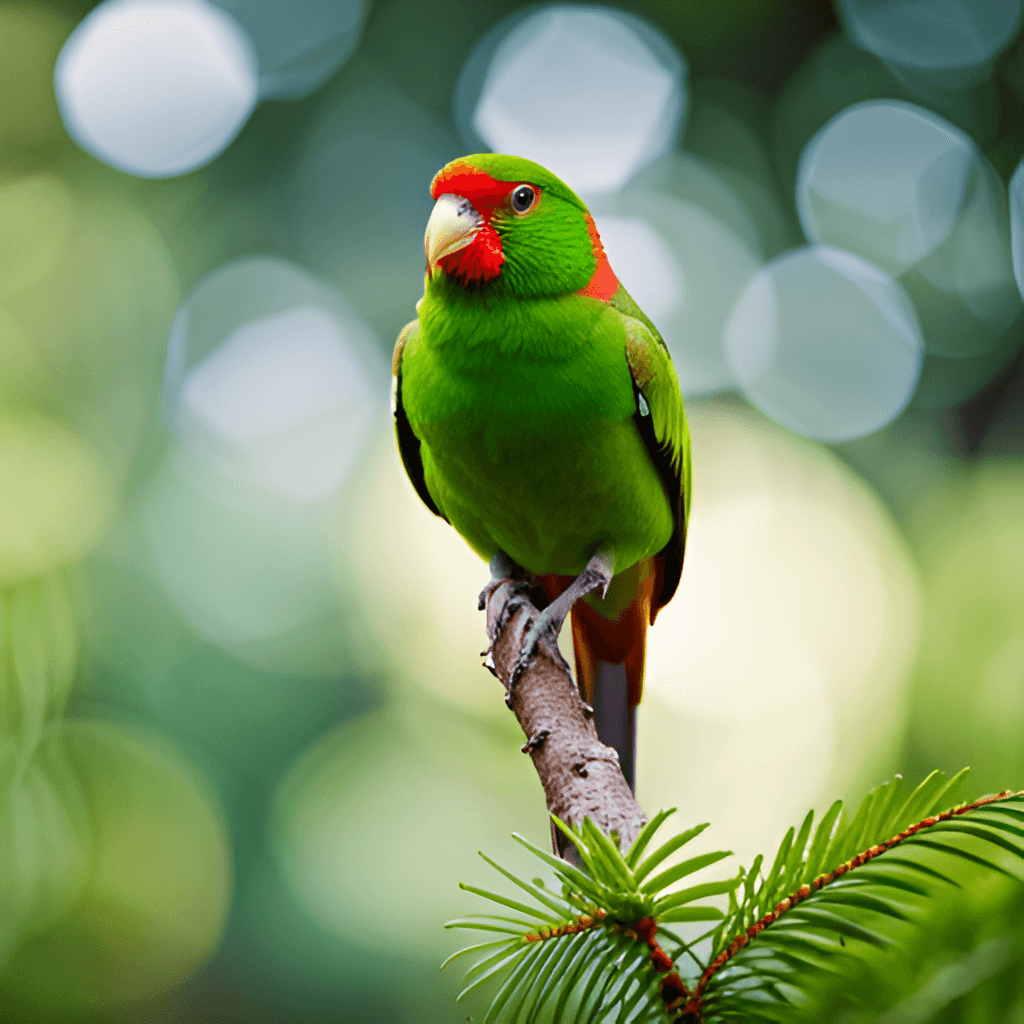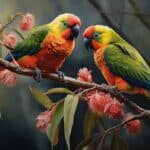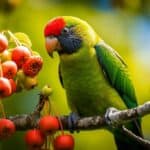The kakariki, also known as the New Zealand parakeet, is a small parrot that is native to New Zealand. There are three kakariki species, all commonly kept as pets due to their friendly and playful personalities. These birds are known for their vibrant green feathers and colourful markings on their heads.
Kakariki are highly intelligent birds that require a lot of attention and stimulation to thrive. They are social creatures that enjoy spending time with their owners and can be trained to perform a variety of tricks. These birds are also known for their vocal abilities and can be taught to mimic words and sounds.
Despite their popularity as pets, kakariki are also important members of New Zealand’s native wildlife. These birds play an important role in pollinating native plants and dispersing seeds throughout the forest. Unfortunately, many species of kakariki are threatened by habitat loss and predation by introduced species such as rats and stoats. Conservation efforts are underway to protect these birds and ensure their survival for future generations.
Kakariki Origin
Kakariki, also known as New Zealand parakeets, are a species of parakeets that are native to New Zealand. The word “kakariki” is derived from the Māori language, where “kaka” means parrot and “riki” means small.
There are three species of kakariki: the red-crowned kakariki (Cyanoramphus novaezelandiae), the yellow-crowned kakariki (Cyanoramphus auriceps), and the orange-fronted kakariki (Cyanoramphus malherbi). All of them are endemic to New Zealand, meaning they are found nowhere else in the world.
Kakariki were once widespread throughout New Zealand, but their populations have been declining due to habitat loss, predation by introduced mammals, and disease. The red-crowned and orange-fronted kakariki are now classified as endangered, while the yellow-crowned kakariki is considered vulnerable.
These parakeets are known for their vibrant plumage, which varies depending on the species. The red-crowned kakariki has a bright green body with a red crown, while the yellow-crowned kakariki has a yellow crown and a green body. The orange-fronted kakariki has a green body with an orange forehead.
Overall, kakariki are fascinating birds with a unique history and biology. Their origin in New Zealand makes them an important part of the country’s natural heritage and a symbol of its biodiversity.
Physical Characteristics
Kakariki parrots are small, chubby-looking birds with fluffy green feathers all over their body and a distinctive red and yellow crown. They are also known as New Zealand parakeets and are the most common species of parakeets in the genus Cyanoramphus.
Size and Weight
When fully grown, the adult Kakariki parrot measures 25-28 cm and weighs around 65 grams. They have a wingspan of around 5 inches. These birds are relatively small in size compared to other parrot species.
Colour Variations
Kakariki parrots come in a variety of colours. The most common colour is green, but they can also be found in yellow, cinnamon, and yellow-green mutations. These birds are known for their vibrant plumage, which makes them a popular choice as pets.
Lifespan
Kakariki parrots have a potential lifespan of 15-20 years. They can live a long and healthy life with proper care and attention. Providing them with a balanced diet, plenty of exercise, and a clean living environment is important to ensure their well-being.
Overall, Kakariki parrots are beautiful and fascinating birds with unique physical characteristics. Their small size, colourful plumage, and long lifespan make them a popular choice as pets for bird enthusiasts.
Behaviour and Temperament
Kakariki parrots are known for their lively and playful temperament. They are intelligent birds and can be trained to perform tricks and mimic sounds, including human speech. They are also very social and enjoy interacting with their owners and other birds.
Social Behaviour
Kakariki parrots are highly social birds and thrive on interaction with their owners. They enjoy being petted and cuddled, and they will often seek out attention from their owners. They also enjoy playing with toys and other objects and can be trained to perform various tricks.
In the wild, kakariki parrots live in flocks and maintain a strict social hierarchy. They communicate with each other through a range of vocalisations and body language. As pets, kakariki parrots will often form strong bonds with their owners and may become distressed if they are left alone for extended periods.
Vocalisation
Kakariki parrots are known for their wide range of vocalisations. They have a variety of natural calls, including chirps, whistles, and trills. They can also mimic sounds they hear, including human speech, music, and other sounds in their environment.
Kakariki parrots are particularly vocal during the breeding season, when males will sing to attract females. They may also become more vocal when they are excited or agitated.
Overall, the behaviour and temperament of kakariki parrots make them excellent pets for those who are willing to provide them with the attention and interaction they need. These birds can be friendly, outgoing, and entertaining companions with proper training and socialisation.
Habitat
Kakariki parrots are native to New Zealand and inhabit forests and shrublands. They prefer habitats with various trees, shrubs, and plants, often living in small flocks of up to ten individuals. In the wild, they typically feed on seeds, fruit, flowers, and insects.
The Kakariki thrives in varied regional habitats, mostly the open areas such as scrubland, grasslands, and forests. However, habitat loss and hunting for food have caused the Kakariki to become endangered. Introduced predators, such as rats and possums, are the main threats to their survival.
All subspecies of the Kakariki are native to New Zealand and have become endangered due to habitat destruction following human settlement and nest predation by introduced mammals, according to Wikipedia. Scarce on the mainland, Kakariki have survived well on outlying islands.
The Red-fronted Kakariki used to be indigenous to the mainland but is now almost extinct there and more likely to be found on surrounding islands like Stewart Island. The Yellow-fronted Kakariki, on the other hand, can be found more readily on the mainland.
Overall, Kakariki parrots prefer habitats that provide a variety of food sources, shelter, and protection from predators. Their natural habitat has been threatened by human settlement and introduced predators, making conservation efforts critical to their survival.
Diet
Kakariki’s diet should be varied and balanced to ensure they receive all the necessary nutrients to maintain their health and wellbeing. A diet that is high in fat and low in nutrients can lead to obesity, malnutrition, and other health issues.
Kakarikis should be fed a combination of pellets, seeds, fruits, vegetables, and fresh greens. Pellets and complete foods should make up at least 60% of their diet. The remainder of their diet can come from dry and sprouted seeds, fruits, green vegetables, seeding grasses, and other treats.
It is important to note that not all fruits and vegetables are safe for kakarikis to eat. Avocado, chocolate, caffeine, alcohol, and anything high in salt or sugar should be avoided. Kakarikis should also not be fed any food that has been treated with pesticides or other chemicals.
Fresh water should be available at all times. Kakarikis can be messy eaters, so their water should be changed frequently to prevent contamination.
Overall, kakarikis should be fed a balanced diet that meets their nutritional needs. It is important to consult with a veterinarian or avian specialist to ensure that the diet is appropriate for the individual bird’s needs.
Breeding and Reproduction
Kakariki are known for their breeding abilities and are popular among bird enthusiasts for their beautiful offspring. In their natural habitat, the breeding season depends on varying climatic conditions; they may breed any time of year, but breeding mainly occurs between October and December.
Kakariki can lay up to 13 eggs, but the more usual number is 6-9. When breeding, the hen will need a suitable nesting box. The box should be at least 12″ x 8″ (300 mm x 200 mm), and filled with 2-3 inches (60-80mm) of Easi bed (or sawdust) and peat mixed together for nesting material. Some hens will lay eggs without a mate, but it is best to have a pair for successful breeding.
Kakariki are monogamous birds and will form strong pair bonds. The male will often feed the female during the incubation period, which lasts approximately 18-21 days. After hatching, the young birds will be fed by both parents and fledge at around 5-6 weeks old.
It is essential to provide a healthy and varied diet for the breeding pair, including fresh fruits and vegetables, seed mix, and a source of calcium, such as cuttlefish bone, to ensure successful breeding. It is also important to ensure that the breeding pair is housed in a suitable environment, with enough space to move around and exercise.
Overall, breeding Kakariki can be a rewarding experience for bird enthusiasts. With proper care, a healthy diet, and a suitable nesting box, these birds can produce beautiful offspring and provide endless entertainment for their owners.
Health Issues
Common Diseases
Kakariki parrots are generally hardy birds with 10 to 15 years of lifespan. However, they can still be susceptible to certain health issues. The following are some common diseases that can affect kakariki parrots:
- Psittacosis: This bacterial infection can affect all parrots, including kakariki. Symptoms include lethargy, loss of appetite, and respiratory distress. It can be transmitted to humans, so it’s important to seek veterinary care immediately if you suspect your bird may have psittacosis.
- Feather Plucking: Feather plucking is a behavioural problem that can affect kakariki parrots. It can be caused by stress, boredom, or a lack of mental stimulation. If you notice your bird plucking its feathers excessively, it’s important to address the underlying cause and provide your bird with plenty of toys and activities to keep it mentally stimulated.
- Mites and Lice: External parasites like mites and lice can cause feather loss and skin irritation in kakariki parrots. Regular grooming and cleaning of the bird’s environment can help prevent infestations.
Preventive Care
Preventive care is key to keeping your kakariki parrot healthy. The following are some tips for preventing health issues in your bird:
- Regular Veterinary Check-Ups: Regular check-ups with a avian veterinarian can help detect health issues early and prevent them from becoming more serious.
- Proper Nutrition: A balanced diet is essential for maintaining good health in kakariki parrots. A diet consisting of high-quality pellets, fresh fruits and vegetables, and occasional treats can provide your bird with the nutrients it needs to stay healthy.
- Clean Environment: A clean environment is important for preventing the growth of harmful bacteria and parasites. Regular cleaning of your bird’s cage and toys can help prevent the spread of disease.
- Mental Stimulation: Kakariki parrots are intelligent birds that require mental stimulation to stay healthy. Providing your bird with plenty of toys and activities can help prevent behavioural problems like feather plucking.
By following these tips and providing your kakariki parrot with proper care, you can help ensure your bird stays healthy and happy for years.
Kakariki and Human Interaction
Kakariki make great pets due to their playful and entertaining personalities. They are also known for their ability to mimic human speech, making them an attractive option for those who want a talkative bird. However, it is important to note that not all kakariki will learn to talk, and even those that do may not be as clear as other parrots.
When it comes to human interaction, kakariki can be trained to be comfortable around people. However, it is important to socialise them from a young age. If they are not exposed to humans regularly, they may become fearful and aggressive towards people.
Kakariki can be trained to step up onto a person’s hand or shoulder, but it is important to use positive reinforcement techniques. Punishing a kakariki for not doing what it is told can cause it to become scared and aggressive. Instead, rewarding it with treats or praise for good behaviour will encourage it to repeat the desired behaviour.
Providing kakariki with plenty of toys and stimulation is also important to prevent boredom. They are active birds and need plenty of space to fly and play. A large cage or aviary with plenty of perches and toys will keep them entertained and happy.
Overall, kakariki can make great pets for those who are willing to put in the time and effort to socialise and train them properly. They can learn to be comfortable around people with patience and positive reinforcement and even become talkative companions.
Conservation Status
Kakariki is a bird species that is endemic to New Zealand. The species’ conservation status is considered “near threatened” with a declining population. The bird is threatened by habitat loss, predation by invasive species, and disease.
Efforts have been made to protect and conserve the species. The New Zealand Department of Conservation has implemented various conservation measures to protect the bird, including predator control, habitat restoration, and captive breeding programmes. In addition, the World Parrot Trust has also been working to conserve the species through research, education, and awareness-raising initiatives.
Kakariki is listed on Appendix II of the Convention on International Trade in Endangered Species of Wild Fauna and Flora (CITES), which means that trade in the species is regulated to ensure that it is sustainable and does not threaten the survival of the species.
The species is also protected under the Wildlife Act 1953 and the National Parks Act 1980 in New Zealand. These acts prohibit the hunting, killing, or capturing of the bird, and also prohibit the destruction of its habitat.
Overall, the conservation status of the kakariki remains a concern, but efforts to protect and conserve the species are ongoing.



Have comments or questions about this article? Then get involved!
Spotted an error or something we have missed? Let us know